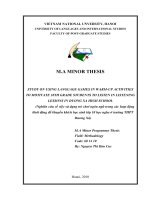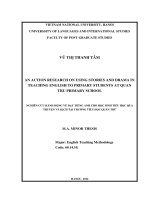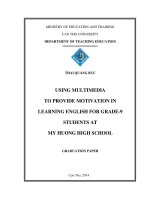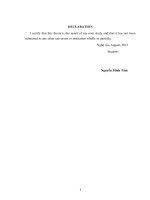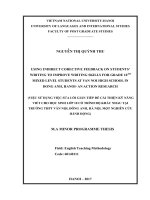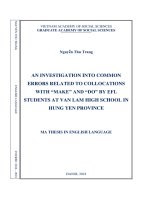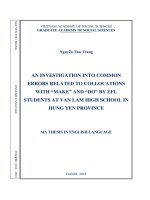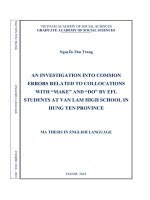Using songs and poems in teaching English into motivate students at Van Noi High school= sử dụng bài thơ, bài hát trong dạy tiếng Anh nhằm gây hứng thú cho học
Bạn đang xem bản rút gọn của tài liệu. Xem và tải ngay bản đầy đủ của tài liệu tại đây (2.46 MB, 93 trang )
VIETNAM NATIONAL UNIVERSITY, HANOI
UNIVERSITY OF LANGUAGES AND INTERNATIONAL STUDIES
FACULTY OF POST- GRADUATE STUDIES
* * *
NGUYỄN THỊ THÚY HÀ
USING SONGS AND POEMS IN TEACHING ENGLISH TO
MOTIVATE STUDENTS AT VAN NOI HIGH SCHOOL
(SỬ DỤNG BÀI HÁT, BÀI THƠ TRONG DẠY TIẾNG ANH
NHẰM GÂY HỨNG THÚ CHO HỌC SINH TẠI TRƯỜNG THPT VÂN NỘI)
M.A MINOR THESIS
FIELD: ENGLISH TEACHING METHODOLOGY
HANOI, SEPTEMBER, 2011
VIETNAM NATIONAL UNIVERSITY, HANOI
UNIVERSITY OF LANGUAGES AND INTERNATIONAL STUDIES
FACULTY OF POST- GRADUATE STUDIES
* * *
NGUYỄN THỊ THÚY HÀ
USING SONGS AND POEMS IN TEACHING ENGLISH TO
MOTIVATE STUDENTS AT VAN NOI HIGH SCHOOL
(SỬ DỤNG BÀI HÁT, BÀI THƠ TRONG DẠY TIẾNG ANH
NHẰM GÂY HỨNG THÚ CHO HỌC SINH TẠI TRƯỜNG THPT VÂN NỘI)
M.A MINOR THESIS
FIELD: ENGLISH TEACHING METHODOLOGY
CODE: 601410
HANOI, SEPTEMBER, 2011
iv
TABLE OF CONTENTS
Candidate’s statement
i
Acknowledgements
ii
Abstract
iii
Table of contents
iv
List of tables
viii
List of abbreviations
ix
PART A: INTRODUCTION.
1
1. Rationale
1
2. Aims of the study
2
3. Method of the study
2
4. Significance of the study
2
5. Scope of the study
2
6. Design of the study
3
PART B: DEVELOPMENT
4
CHAPTER 1: LITERATURE REVIEW
4
1.1. Motivation
4
1.1.1. What is motivation?
4
1.1.2. Motivation and attitude
4
1.1.3. Motivation in second language learning
5
1.2. Learning English through songs
6
1.2.1. Reasons for using songs in the language classroom
6
1.2.2. How can songs be used in language teaching?
7
1.2.3. Choosing suitable songs and teaching procedure
8
1.3. Learning English through poems
10
1.3.1. Reasons for using poems in language classroom
10
1.3.2 How can poems be used in language teaching?
11
v
1.3.3. Choosing suitable poems and teaching procedure
12
1.4. Previous studies in ULIS and difficulties to apply the idea of teaching
English through songs and poems in high schools
14
CHAPTER 2: METHODOLOGY
15
2.1. Setting of the study
15
2.2. Research Questions
16
2.3 Research Methodology
16
2.4. Participants
17
2.5. Instruments to collect data
17
2.5.1 Questionnaires
17
2.5.2 Students’ Reflections
18
2.6 Data Collection Procedure
19
2.7. Methods of Data Analysis
20
CHAPTER 3: FINDINGS AND DISCUSSIONS
21
3.1. Pre – questionnaire data and analysis
21
3.1.1. Students’ Motivation and Attitudes to Learning English before the
treatment
21
3.1.2. Students’ Attitudes towards Learning English through Songs and Poems
before the treatment
23
3.2. Changes in Students’ Motivation and Attitudes
24
3.3. Attitudes towards learning English through songs and poems after the
treatment
26
3.4 Songs and poems that students like to learn
28
vi
3.5 The Degree of suitability of songs- and poems-based activities as ranked
by the students
30
3.6 Students’ reflections on learning through songs and poems.
31
3.6.1. Students’ worksheets
31
3.6.2. Students’ sayings about learning through songs and poems:
31
3.6.3. Students’ collections of their favorite songs.
32
PART C: CONCLUSION
34
1. Major Findings
34
2. Pedagogical Implications
35
2.1. Integration of songs in the teaching English in high schools.
35
2.1.1 Choosing the song for the topic of the unit that the song is taught
along with
35
2.1.2 Designing tasks for the songs
36
2.1.3 Procedure to teach a song
36
Integration of poems in the teaching English in high schools.
37
Choosing the poem for the topic of the unit or for the pronunciation or
grammar items in the unit that the poem is taught along with:
37
Designing tasks for the poems:
37
Procedure to teach a poem (These steps are quite like the ones to teach a
song)
38
3. Limitation of the study
38
4. Suggestions for further study
38
REFERENCES
40
APPENDICES
I
Appendix 1: Tieng Anh 10 Teaching Schedule
I
vii
Appendix 2: English through songs and poems schedule
III
Appendix 3: Pre – questionnaire
V
Appendix 4: Post – questionnaire
VI
Appendix 5: Examples of poems in the English textbook at Lower Secondary
School
VIII
Appendix 6a-j: 10 worksheets of teaching English through songs and poems
IX –
XXVIII
Appendix 7: List of Internet links to learning English through songs and
poems in Vietnam
XXIX
Appendix 8: Students’ reflections: (extract from some of students’ song
books):
XXXII
Thu Huyen’s diary
XXXI
Nguyen Thi Tu Linh’s song book
XXXIII
Nguyen Thi Phuong’s song book
XXXVII
LIST OF TABLES
viii
Table 1: Students’ motivation and attitude to learning English before the treatment
Table 2: Attitude towards learning English through songs and poems before the treatment
Table 3: Students’ motivation and attitude to learning English after the treatment
compared with those before the treatment
Table 4: Attitude towards learning English through songs and poems after the treatment:
Class 10B only
Table 5: Songs and poems that students preferred and their ranking
Table 6: Learning relevance towards the English through songs and poems activities
LIST OF ABBREAVIATIONS
ix
ULIS: University of Languages and International Studies
EFL : English as Foreign Language
TESOL: Teaching English to Speakers of Other Languages
G1 : Experimental group
G2 : Control group
X : Treatment
T1 : Pretest
T2: Posttest
1
PART A: INTRODUCTION
1. Rationale
It is commonly believed that motivation is key to a student‟s success. In today‟s classroom,
keeping learners motivated is a main concern for educators. Motivation stimulates the interest
of students and inspires them to take part in classroom activities. Therefore, one of the teacher‟s
responsibilities is to find ways to motivate the students. In the motivation literature, a variety of
motivational strategies have been suggested, but scholars also advise teachers to apply those
strategies selectively taking into consideration the learner variables such as their age, their level
of proficiency, the type of the language teaching course, etc.
Understanding how students are motivated can help teachers engage them in the
classroom. “Engagement is 99% of teaching. If you get students‟ attention and keep it, the
lessons themselves are so much easier!” (Nicole Foley, personal interview, September 16,
2006)
Knowing that importance of learning motivation, numerous studies have been carried out to
investigate students‟ motivation and strategies to motivate students to learn. Taking an
example, among 740 M.A theses in the library of Faculty of Post – Graduate Studies in
University of Languages and International Studies (ULIS), there are about 24 theses on this
topic. It is clear that students‟ low motivation is common problem in schools, not only at Van
Noi High School. Various ways have been tried to motivate their students to learn English such
as using folktales, songs, language games, visual aids, examination taking strategy training, etc.
And they got the certain results.
There are two things that make humans different from all other animals. They are language
and music (Tieng Anh 10,2006:124). Music, along with the other arts, invites the imagination
to work, and provides learners with opportunities to make choices, both collaboratively, and
alone. Music enhances our students' motivation to learn, and improves upon their engagement
and retention. In fact, teenagers and music are inseparable. Therefore, songs have been widely
used in language teaching. Songs relax and get rid of negative emotion. Many songs are poems
in themselves or the lyrics of the songs are very rich in poetry. Both songs and poems are
authentic materials which are written with the writers‟ real emotion and the words are chosen
for their beauty and sounds are carefully arranged. According to Murphey (1992:3) songs are
highly memorable and motivating in language learning and “its motivational appeal is present
to many different types of learners.” Although poems are not as popular to students as songs,
2
poetry promotes language acquisition. (Holmes, V. L. & Moulton, M. R, 2001). For the above
reasons, a quasi-experimental research was conducted in Van Noi High School to test the
hypothesis of using songs and poems to motivate students to learn English.
2. Aims of the research
The research aimed:
- To find out how the use of songs and poems in teaching English enhances the students‟
motivation in learning English.
- To find out what kind of songs and poems can make high school students motivated
- To find out which class activities are suitable for using songs and poems
at a high school.
3. Method of the study
With the aim to investigate the extent to which the use of songs and poems help to motivate
the grade 10
th
students in learning English, a quasi – experimental method was employed with
two instruments to gather data, questionnaires (the pre- and post-treatment questionnaire) and
students‟ reflections. The pre-questionnaire was used to measure students‟ motivation and
attitude to learning English and leaning English through songs and poems at the beginning of
the research. Data obtained from the questionnaire were used as the criteria to determine the
experimental group and the control group to make the research more comparable. The post-
questionnaire was administered at the end of the research to see if there was any increase in
students learning motivation and what their favorite songs and poems as well as their preferred
learning-English-through-songs-and-poems activities were.
4. Significance of the study
The study provides information about whether the use of songs and poems in the classroom
helps to increase the students‟ motivation in learning English, and if songs and poems are
useful, how classroom activities can be designed with songs and poems. This could be a
contribution to the understanding of the value of songs and poems as a motivational strategy.
5. Scope of the study
With the scope of a quasi-experimental using two 10
th
grade classes, extraneous variables
could not be controlled. Therefore, the research results do not have high generality and may
only match the situation at Van Noi High School. With the limited time of two months, no more
than five songs and five poems have been taught to experimental group along with their English
3
curriculum. The data collection instrument was only using questionnaires, which may lead to
insufficient research results. This research focused only on the aspect of motivating students by
using songs and poems. The other factors of using songs and poems to teach English will be not
discussed here.
6. Design of the study
The study is organized around three parts with three chapters:
Part A- Introduction- consists of the rationale of the study, aims of the study, scope of the
study, significance of the study, research methodology and design of the study.
Part B- Development- is divided into three following chapters:
Chapter 1 – Literature Review - provides a review of related literature, in which the
definition of motivation, the role of motivation in language learning are discussed first. It then
deals with the reasons and the way to use songs and poems in EFL class.
Chapter 2 – Methodology - presents the situation of learning English through songs and
poems in Vietnam, the research questions, the research methodology, the participants, the
instruments and method of analyzing data.
Chapter 3 – Findings and Discussions - provides the findings and discussions through an
analysis of all data collected by means of pre and post – questionnaires and students‟ reflections
Part C- Conclusion - summarizes the main findings in the study, and made some
recommendations on how to use songs and poems in class to motivate students. It also
discusses the limitations of the study and makes some suggestions for further research.
4
PART B: DEVELOPMENT
CHAPTER ONE: LITERATURE REVIEW
This chapter presents a review of related literature, in which the definition of motivation
and motivation in language learning are discussed first. It then deals with the reasons for and
the ways of using songs and poems in EFL class.
1. 1. Motivation
1.1.1. What is motivation?
There is always a drive or need for one to know what is happening around oneself. What
motivates someone‟s drive or intention to satisfy one‟s needs is a topic of interest in
motivational psychology. The evolution of motivation as a theoretical construct was established
in the early twentieth century. Behaviorist psychology in the middle of the twentieth century
stresses “reinforcement as the primary mechanism for establishing and maintaining behavior”
(Brophy, 1998:3).
During the 1960‟s, cognitive psychologists emphasized the need to understand “how mental
processes are transformed into action” (Dornyei, 2001:7) which focus on how attitudes,
thoughts, beliefs, and interpretation of events influence individual behavior (Dornyei, 2001).
Dornyei (1998:118) attempted to achieve a synthesis of the static and dynamic conceptions of
motivation by defining it as a “process whereby a certain amount of instigation force arises,
initiates action, and persists as long as no other force comes into play to weaken it and thereby
terminate action or until the planned outcome has been reached”.
1.1.2. Motivation and attitude
Many teachers in their experience of teaching “recognize that motivation is important
for learning and therefore want to have motivated students” (McCombs & Pope, 1994:9). There
is always a question that teachers like to ask: “why is student A more active than student B in
participating class activities? Student A raises questions during language lessons and no matter
how inattentive the rest of the students are, he has his own way to learn. Student B, on the other
hand, is claimed to be cleverer, and without using much effort, he gets high marks in tests.
From teacher‟s point of view, student A is more motivated than student B despite the higher
intellectual capacity and language aptitude of student B. In the eyes of social psychologists,
there is more involvement in second language learning. The student‟s attitudes, his readiness to
5
identify and his orientation to the learning process are the keys to the success in mastering a
foreign language (Gardner & Lambert, 1972).
1.1.3. Motivation in second language learning
According to Lightbown & Spada (2002), motivation in second language learning can
be defined in terms of two factors: learners‟ communicative needs and their attitudes towards
the second language community. If learners need to speak the second language in a wide range
of social situations or to fulfill professional ambitions, they will appreciate the communicative
value of the second language and will therefore be motivated to acquire proficiency in it.
Likewise, if learners have favorable attitudes towards the speakers of the language, they will
desire more contact with them. That is motivation to learn a second language is seen as
referring to the “extent to which the individual works or strives to learn the language because of
a desire to do so and the satisfaction experienced in this activity” (Gardner, 1985:10-11).
Gardner & Lambert (1972:132) described two forms of student‟s orientation in detail.
Instrumental orientation reflects “the practical value and advantages of learning a new
language” and integrative orientation reflects “a sincere and personal interest in the people and
culture represented by the other group”.
Instrumental orientation has always considered being the major force to determine
success in L2 learning as students are motivated by the opening of educational and economic
opportunities for them. Integrative orientation describes L2 learners that are interested in the
people and culture represented by the target-language group (Ellis 2003). It is more typical of
immigrants into a language community attempting to integrate into that society. According to
Gardner & Lambert (1972:132), “It was our hunch that an integrative orientation would sustain
better the long-term motivation needed for the very demanding task of second-language
learning”.
In the book “The practice of English language teaching”, Hammer (1994) defined
motivation as some kind of internal drive that encourages students to pursue a course of action.
He separated motivation into extrinsic and intrinsic motivation. Extrinsic motivation is
concerned with factors beyond the classroom and “is caused by any number of outside factors
such as the need to pass an exam, the hope of financial reward or the possibility of future
travel” (Hamer 2001: 51). On the other hand, intrinsic motivation, as Harmer pointed out, is
concerned only with what takes place inside the classroom. Especially, he gave detailed
6
analysis on factors affecting intrinsic motivation. Those factors are physical condition,
methods, teachers and success.
In “Teaching by principles” (H. Douglas Brown, 1994), the author emphasized that
motivation is the extent to which students make choices about goals to pursue and the effort
they will devote to that pursuit. Although he discussed both intrinsic and extrinsic motivation,
he clearly expressed a particular interest in intrinsic motivation in the context of language-
learning classes.
According to Moore (1992: 173) “Intrinsic motivation is what learners bring to the
learning environment, that is, their internal attributes: attitudes, values, needs and personality
factors. In contrast, extrinsic motivation originated outside the individual and is concerned with
external environmental factors that help shape students‟ behavior”
This study especially focused on “intrinsic motivation” referring to “motivation to engage in
activity for its own sake” by Pintrich and Strunk (2002:245). The pre and post questionnaires
used to measure the students‟ motivation before and after the treatment were designed with
statements that show students‟ intrinsic and extrinsic motivation based on the definitions above.
(See Appendix 3, 4)
1.2. Learning English through songs
1.2.1. Reasons for using songs in the language classroom
There are a number of reasons for using songs in the classroom. Firstly, music brings
enjoyment to the language classroom. Many language teachers like to use music in their
language classrooms as music brings enjoyment and fun to people‟s lives. Music plays an
important role in culture and communication (Murphey, 1990) as “cultures have musical
traditions because of the enjoyment people receive from creating rhythms and expressing their
feelings, ideas, thoughts, and cultural values through lyrics” (Abbott, 2002:10). Secondly, songs
motivate language learning. Murphey (1990) & Davanellos (1999) state that music and songs
are highly motivating and relaxing. The readily made music material with its conversation
language and repetition patterns are what language teachers look for to motivate different types
of language learners. It provides variety and fun. Murphey (1990:5-8) claims that “songs can be
immensely valuable for developing certain capacities, but they can be many times more
valuable if we exploit them creatively to bridge the gap between the pleasurable experience of
listening/singing and the communicative use of language”. Thirdly, songs also sustain students‟
7
interest in learning. Davanellos (1999:13) pointed out that “Songs are highly memorable”. The
length of a song is more manageable for the allocation of time for class instruction (Chan,
1997) when compared with some lengthy comprehensive articles. It is easier to sustain
students‟ interest when students‟ attention is more focused on the general meaning of the text
(Chan, 1997). The repetitive patterning of the songs reinforces learning without loss of
motivation (Murphey, 1990) and as Bechtold (1983:180) notes “songs can help reinforce
specific teaching items.… Normally songs should not introduce language items; they should
reinforce them”. The pleasurable learning through songs experience enables students to practice
pronunciation (Monreal, 1982), rhythm and stress, syntax and vocabulary as “a good teacher
will take precautions to ensure that the language which the song reinforces is natural and
useful” (Bechtold, 1983:181).
1.2.2. How can songs be used in language teaching?
Automatic usual and simple answer to this question could be: “A word-gap-fill.”
However, the answer is not so single valued. And hopefully, the selected list of Tim
Murphey(1992: 9-10) (and references to other sources of activities) will be convincing enough
to prove that the answer can be much longer. From the list, it can be seen that songs can be used
in various ways. All the skills such as listening, reading, writing and speaking can be practiced,
the same way as linguistic areas starting with vocabulary, grammatical structures, and ending
with rhythm, stress, fluency and pronunciation.
The rhythm of the verse helps the learner to put the stress in the right places, creating
a natural flow of language and building up fluency. At the same time the presence of rhyming
words and such poetic device as alliteration and onomatopoeia help to focus on certain sounds,
thus giving valuable ear-training and help in pronunciation. In the syntactical area a song gives
us the opportunity to repeat the same structural item many times, thereby aiding correctness and
fluency of expression. (Ward, S. A, 1980: 7)
Songs are also “especially good at introducing vocabulary because they provide a
meaningful context for the vocabulary”. However, it depends on the choice of songs since there
are also some songs without meaningful context. From the grammatical point of view, they
“provide a natural context for the most common structures such as verb tenses and
prepositions” (Griffee, D. T, (1995): 5, 6).
8
Abbott (2002:11) claimed that “the activity or content of the songs should be related to
the theme, topic, or functions that are covered in class. Simple, repetitive songs often contain
recurrent grammatical patterns and can be used as grammar practice activities”. A number of
activities can therefore be integrated with the relevant grammar patterns when using songs to
motivate students in language learning.
The effectiveness of using songs to motivate language learners can be highlighted with
the careful choice of vocabularies and grammar in response to the students‟ level of mastery
(Jolly, 1975). In addition, students can reconstruct the form of the songs that they are familiar
with, by changing the narrative point of view from one to another, student can be a lyric writer
in a composition activity (Chan, 1997).
Songs are especially useful to students whose language is syllable-timed for practicing
the stress pattern of spoken English. The regulated and stronger rhythm of songs as compared
with speech can be used to practice the patterns formed by stressed and unstressed syllables.
Other activities include asking students to guess the title of a song after listening to it and lyrics
of the songs can be used as a tool for comprehension practice when students listen and dictate
(Chan, 1997).
1.2.3. Choosing suitable songs and teaching procedure
For teenagers or adults in the intermediate or advanced level, it is better to use more
meaningful or popular songs, which not only review or introduce grammar points but also
reflect cultural aspects (Horner, D, 1993). At the primary level of singing the song, the prosodic
features of the language is emphasized. At the higher levels, where the practice of grammar
points is at the foreground, songs can be used with several techniques. Some examples of these
techniques are:
Gap fills or close texts
Focus questions
True-false statements
Put these lines into the correct sequence
Dictation
Add a final verse
Circle the antonyms/synonyms of the given words
9
Discuss
The following procedure to teach a song by Eken, D.K. (1996) in an English teaching
forum seems to be suitable for high school teaching:
After deciding the grammar point to be studied, and the song and the techniques to be used,
the teacher should prepare an effective lesson plan. Since songs are listening activities, it is
advisable to present them as a listening lesson, but of course it is necessary to integrate all the
skills in the process in order to achieve successful teaching. When regarding a lesson plan, as a
pre-listening activity, the theme, the title, or the history of the song can be discussed. By
directing the students toward specific areas, problem vocabulary items can be picked up in
advance. Before listening to the song, it is also beneficial to let the students know which
grammar points should be studied. At this stage, pictures may also be used to introduce the
theme of the song. In the listening stage, some of the techniques listed above can be used, but
among them gap filling is the most widely used technique. Through such gaps, the vocabulary,
grammar, or pronunciation is highlighted. This stage can be developed by the teacher according
to the needs of the students and the grammar point to be studied. In the follow-up, integrated
skills can be used to complete the overall course structure. Since many songs are on themes for
which it is easy to find related reading texts, it may lead the learner to read a text about the
singer or the theme. Besides, many songs give a chance for a written reaction of some kind.
Opinion questions may lead the learner to write about his own thoughts or reflections. Some
songs deal with a theme that can be re-exploited through role plays. Acting may add enthusiasm
to the learning process. Finally, some songs deal with themes, which can lead to guided
discussion. By leading the students into a discussion, the grammar point could be practiced
orally and, in a way, naturally.
As a consequence, the use of songs in language classrooms provides many advantages.
They entertain and relax the learners while they are learning or practicing a structure, and they
often eliminate the students‟ negative attitude towards learning. Through providing authenticity
and context they make the grammar points more understandable and easy. As language
teachers, we can benefit from using songs, since our concern is to motivate the students and
draw their utmost attention on the subject during teaching.
10
1.3. Learning English through poems
1.3.1. Reasons for using poems in language teaching.
Poems are included in the English textbooks for lower secondary school students in
Vietnam. In many units, especially in Tieng Anh 7 (2006) ( See examples poems in Appendix
5) there are two poems in the part “Play with words”, which are written for the topic of the unit
and with the rhyme words for students to practice pronunciation and to find out the interesting
ideas in the poems and it is easy to remember the topic of the unit. However, most of the
English teachers I know skip this part. They do not find reading it important compared with the
other parts of the unit. It is a great pity to underestimate the role of poetry in language teaching.
In fact, poetry is terrific material for EFL class. As we know, most of the materials
written for EFL class are centered on some topics for grammar or for communicative
competence. Being exposed to the kind of material for a long period of time, students will
inevitably become tired of them for lack of intellectual inspiration. But poetry can turn the
dullness into excitement, for it can offer “many pleasures pleasures of sound and meaning, of
image and symbol, of speech and feeling and thoughts.” (DiYanni, 1998) With the teaching of
poetry, students can be motivated not only to learn English but also to appreciate the deeper
dimension and exquisiteness of the language.
In addition to the linguistic benefits poetry provides, it can foster the aesthetic sense of
students. Poems are usually composed of condensed words and vivid images. Reading them can
make us more receptive to imagination and improve our ability in appreciation of beauty
(DiYanni, 1998). Moreover, our experience and feeling will be strongly evoked to look into
ourselves and look around the outer world. It is the kind of mental process that makes one a
lifelong reader.
V. L. Holmes and M. R. Moulton offer explanation of language acquisition through
poetry, and they give reasons for using poetry in language teaching. Children are often
introduced to poetry early in their lives by parents, grandparents, and other caretakers who
chant nursery rhymes or sing lullabies to soothe their children‟s anxiety – all before the
youngsters have any consciousness of linguistic forms. Many children learn their first words
from poems because the sounds of poetic language, with its patterns of rhythm, rhyme, and
cadence, intrigue them and make them listen carefully. Linguists suggest that early knowledge
of syntax comes from children listening to language forms from their environments. More often
11
than not, those forms are poetic. Poetry teaches children to listen, develop vocabulary, learn to
read and write, and think creatively. For some of the same reasons that poetry is useful in
acquisition of a first language, it is an effective way of learning and reinforcing the sounds and
structures of a second, or even third, language. Through listening to poetry, second language
learners can reinforce target language learning in a natural way. (V. L. Holmes and M. R.
Moulton, 2001:3)
1.3.2. How can poems be used in language teaching?
Poems, like songs, contextualize a grammar lesson effectively. Since poetry is often
spoken, repeated, dealt with, and considered, it acts as an effective tool for practicing a specific
grammatical structure. Through repeating and considering the poem, the grammatical structures
become more deeply internalized. Thus, poetry not only provides a rewarding resource for
structured practice of grammar, but also a proper basis for review. If a poem that exemplifies a
particular structure is also a good poem, it engages the eye, the ear and the tongue
simultaneously while also stimulating and moving us; this polymorphic effect makes poetry
easier to memorize than other things for many students (Celce-Murcia and Hills, 1988:123).
Like songs, poems exaggerate the rhythmic nature of the language. Thus it is an
important aspect to be taught, since English is a syllable timed language with stressed syllables
being spoken at roughly equal time pauses, even in everyday speech. Similar to songs, poems
have an enormous linguistic value as they provide authenticity and cultural views. A poem's
capacity to comfort the reader or the listener also increases its effectiveness as a teaching
resource. Once a poem or song has been learned, they stay in the minds of the students for the
rest of their lives, with all the rhythms, grammatical features and vocabulary.
Poems may bring the use of creativity and the rhythm into the language classroom,
though they may also bring some difficulties. Poems are not constructed in a simple way and
syntactically they are at a higher level than prose, thus it might be very difficult for a foreign
language learner to comprehend them completely. As stated by Povey (cited in Celce-Murcia
and Hills, 1988) there are three main barriers for literature including poetry. They are linguistic,
cultural, and intellectual barriers. Linguistic difficulties are the problems caused by the syntax
or the lexicon of the poem. Cultural difficulties include imagery, tone, and allusion. At the
intellectual level, the students should be intellectual and mature enough to understand the theme
12
of the poem. These difficulties could be easily removed if the teacher provides a poem which is
syntactically and thematically appropriate to the level, age and the interests of the students.
Thus, by removing or minimizing the potential problems, poetry can provide an enormously
rich, enjoyable and authentic context for foreign language learners.
1.3.3. Choosing suitable poems and teaching procedure
In the selection of a poem, the teacher should first consider the grammatical structure to
be presented, practiced, or reviewed, then the level and the age of the students, next the theme
and the length of the poem and its appropriateness to the classroom objectives. It is advisable to
select a poem from 20th century poets. As older poems often provide a more difficult lexicon
and syntax, and as they reflect some old-fashioned ideas, it is more convenient to use
contemporary poems than older ones. Poems, which reflect cultural themes, universal features,
humanistic values, or emotional aspects, will be more relevant to the foreign language learners.
Finally, through taking the classroom objectives into consideration, a teacher should effectively
benefit from poems as teaching aids.
Celce-Murcia and Hills (1988) suggested a poem‟s teaching procedure which seemed to
be suitable to teaching high school students. At the teaching stage of a poem, it is not advisable
to talk about the meaning of the poem in advance. Since they offer a reading and listening
activity, poems could be presented through a reading plan. At the pre-reading stage, students
might be motivated through some enthusiastic talks about poetry or the poet. Some necessary
vocabulary can also be handled at this stage. At the reading stage, in order to create images and
stress the prosodic features, the teacher may want the students to close their eyes while he/she is
reading the poem. After the poem has been read at least twice, it is better to elicit the primary
responses of the students about the poem. Next, after distributing the poem to students, students
may be asked to read it either loudly or silently. In order to practice the determined grammar
point, students may be asked to paraphrase the poem. Through transforming the verse into
prose students get acquainted with the structure.
After easing the grammar and understanding the vocabulary, students get an idea about
the theme of the poem. Reading the paraphrased poem reinforces the grammatical structure
under consideration. Asking questions about context may follow the reading. Through asking
13
Wh- questions, providing additional information about the culture and asking students to share
their experience with the subject matter, the cultural content of the poem becomes more real
and vivid. Words, pictures, and shared experiences can eliminate the gap that is created by
different cultures, as no one can deny that poems cannot always evoke the same sounds, sights,
smells, and associations for both native speakers and foreign language learners. After
discussing the surface content of the poem, students may again asked to close their eyes and
visualize the poem while listening to it.
As a follow-up activity a discussion may be held. After reviewing the plot of the poem
and providing adequate artful questions, the students will eventually discover the deeper
meaning of the poem. As being a facilitator, a teacher should always avoid telling the meaning.
After each student grasps his or her own meaning, it is proper to discuss the depth of the poem.
In this procedure, the teacher's aim is to support the students in their attempts to understand the
poem and make it relevant to their lives. Once they have understood it and perceived its
relevance, they will have no objection to practicing the poem or even memorizing it, for it will
have become special for them (Celce-Murcia and Hills, 1988:126). At the follow-up stage,
providing the determined structure, students may also be asked to write a poem about anything
they want. In such a procedure the four skills are effectively integrated to practice or present
any grammar point.
Since every class is different, teachers should creativity determine the teaching
procedure. It is not advisable to apply one procedure too strictly. A teacher should adopt the
activities according to the needs of the learners. However, it might not be very useful to use
poems for young students or for beginners. Instead of poems, using nursery rhymes or songs
would be more helpful since they provide more joyful and easier contexts. From pre-
intermediate to advanced levels, it is really beneficial to use either songs or poems. Several
poems can be adopted from contemporary poem books. The poems of the W.H. Auden, Robert
Frost, Stanley Kunitz, Delmore Schwartz, W.D. Snodgrass, Theodore Roethke, Gary Snyder,
Richard Wilbur, and Robert Lowell, etc. are suggested for the language teachers who want to
use poems in their grammar lessons.
14
1.4. Previous studies in ULIS and difficulties to apply the idea of teaching English through
songs and poems in high schools.
In the Faculty of Post Graduate Studies of ULIS, there have been two theses in which
the authors are interested in using songs in English teaching. One is Nguyen Thi Thanh Huyen
(August, 2006), who used English songs as a kind of supplementary material in teaching
listening skill. The other is Nguyen Thi Moc Lan (August, 2007), who used songs to motivate
her students to learn vocabulary. Taking a look for using poems to teach English, only one
author was found. Nguyen Thi Hong Quyen (2008) integrated short stories and poems in
developing the reading skill for 2
nd
year students in Hai Phong University.
All the three authors used songs and poems in their teaching English at the university.
There may be a lot of difficulties to use songs and poems in high school where all the teachers
have to strictly follow the teaching curriculum with the Textbook by the Ministry of Training
and Education. It seems that there is not any space to integrate songs and poems in teaching
English.
When using Google to search for the answer to the questions how teaching – English –
through – song – and - poem can be applied in high schools, I did not find any teachers in
Vietnam to do this. I only found some high school websites in which there are some pages for
learners to enjoy English songs with lyrics, most of these songs are taken from the learning –
English – through – songs websites listed above. Here are some examples:
/>id/33/postid/818/scope/posts/Default.aspx
There is a collection of English songs with lyrics the same as 7 volumes from
thunglunghoahong.com
This forum has a part for English at secondary schools and there are also some English
songs with lyrics for students to learn.
This forum from Tri An High School with some English songs with lyrics and karaoke
15
CHAPTER TWO: METHODOLOGY
This chapter develops a methodology to examine the experiences of students to be
investigated in the research. The situation of learning English through songs and poems in
Vietnam will be discussed first and then the research questions will be established. Next, the
participants will be described as well as the appropriate research vehicle. These are critical
steps as the research method can influence the accuracy of the data, response rate and the
criteria of the study. Finally the method of data analysis will be explained.
2.1. Setting of the study
Previously, on television, “Sing to Learn” was one of the first Vietnamese programme
which tried to encourage learners to learn English through songs. A lot of famous songs were
taught carefully with the explanations of new words and expressions, grammar points the lyrics
and singing along with a Vietnamese singer. At that time the programme was always waited by
many English learners. In fact there are many other English learners in Vietnam enjoy this way
of learning. They have found many websites to learn English through songs. (See appendix 7).
At a workshop by Hanoi Ministry of Education about five years ago, Nguyen Quoc Hung
introduced teaching English through poems. He translated many English poems into
Vietnamese and invited the singer Duc Chinh recited two of the poems. Many English teachers
enjoyed the poems but they did not seem to interest in the ideas. Some workshops by British
Council held in Melia Hotel in 2004 also mentioned this way of teaching. At one of those
workshops, teachers and students of Trung Vuong Lower Secondary School were asked to
present how they had learnt English through songs, poems and dramas. They gave us handouts
of “Play with words” translations, which was a collection of students‟ Vietnamese translations
from English short poems in Tieng Anh 6 and 7 (2004). (See Appendix 5).
As far as I know, many teachers of English at secondary school think that they do not
have time for those activities and because their students are not good at English to do the
translations. That is why many teachers skip this part of the textbook. And so it is easy to
understand that many of my 10
th
grade students admitted never reading English poems before.
Comparing with so many websites of learning English though songs, there are few websites for
the Vietnamese to learn English through poems. I have sought for learning-English-through-
poems websites but have found only few ones (Appendix 7)
16
2.2. Research Questions
The study was conducted to determine the effectiveness of using songs and poems to
motivate students to learn English at a high school. It aimed to see whether students were more
motivated to learn English through songs and poems. The study was conducted with the
following research questions:
1. Does learning - English - through - songs - and - poems increase motivation in the ESL
classroom?
2. What is the most suitable time to use songs and poems in the English lessons of at high
school?
3. What kinds of songs and poems are high school students‟ favourite ones?
4. What class activities are suitable for teaching songs and poems to high school students?
2.3. Research Methodology
To answer these above research questions, a quasi – experimental research was carried
out in Van Noi High School during the two months at the end of the second term of the school
year 2010 – 2011. This is a nonequivalent groups pretest-posttest design (Gibbons, Barry &
Herman, Joan, 1997). This design was used due to the reason that there was limited of time. As
Hatch and Farhady (1982:23) state: Because of these and many other limitations, constructing a
true experimental design may be difficult if not impossible. A non-equivalent groups design
includes an existing group of participants who receive a treatment and another existing group of
participants to serve as a control or comparison group. Participants are not randomly assigned
to conditions, but rather are assigned to the treatment or control conditions along with all the
others in their existing group.
Following is the formula of the research design:
G1 : Experimental group (Class 10B)
G2 : Control group (Class 10F)
X : Treatment: the use of songs and poems in teaching English
T1 : Pretest (Pre-questionnaire)
T2 : Posttest (Post - questionnaire)
Independent variable: the teaching methodology
Dependent variable: students‟ learning motivation and attitudes to learning English
17
2.4. Participants
Eighty grade 10 students from two classes participated in this study. From the data
obtained in the pre-questionnaire, one of the classes was selected as the experimental group and
they were taught English songs and poems once a week, integrated to the usual English
schedule (See Appendix 2). The control group only learned the usual schedule of Tieng Anh 10
curriculum. (See appendix 1)
The school is situated in the suburban of Hanoi and most of their parents are farmers
and their level of education is generally not high. Their condition to learn English outside the
class is not good. Only some of them have personal computers connected with the Internet.
Most of them do not have chances to attend any English speaking clubs or extra – classes. At
the beginning of the school year 2010- 2011, they showed their low motivation towards
learning English. They did not pay much attention to learning English at Lower secondary
school; therefore their result at the first term test was really bad. It is clear that there is a lot of
room for the teacher to motivate them in learning English.
In order to get a better understanding to the background of the two groups of students,
the pre-questionnaire was filled in by the two classes of students at the beginning of the
research to collect data about their attitude and motivation towards learning English and
learning English through songs and poems.
2.5. Instruments to collect data
According to Brown (2001:6), “questionnaires are any written instruments that present
respondents with a series of questions or statements to which they are to react either by writing
out their answers or selecting from among existing answers”. Two questionnaires (the pre -
questionnaire and and post – questionnaire) were used together with and Students‟ reflections
(including the worksheets, some of their thoughts and feelings towards learning English
through songs and poems, their collections of favorite songs to learns) to collect data in this
study .
2.5.1. Questionnaires
The questionnaires were of the Likert-scale type with six different scales from „Strongly
disagree” to „Strongly agree” which was partly adapted from “The post-experimental intrinsic
motivation inventory” by Ryan, Koestner & Deci (1991) (see Appendix 3,4) There are two
main sections in the pre-questionnaire . Section one was about students‟ English learning
